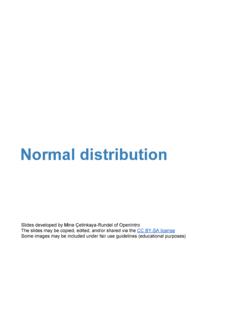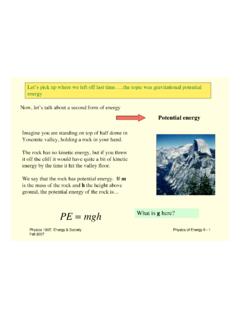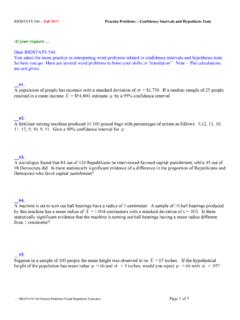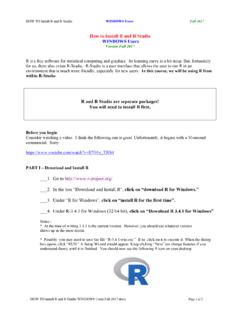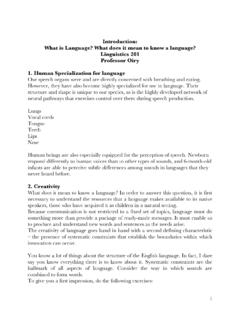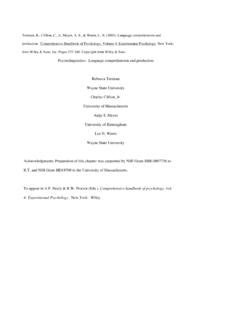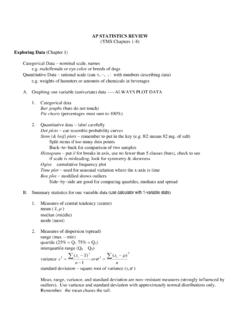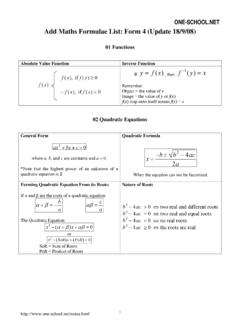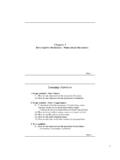Transcription of Lecture 2 – Grouped Data Calculation - UMass …
1 1. Mean, Median and Mode2. First Quantile, third Quantile and Interquantile 2 Grouped data CalculationMean Grouped DataNumberof orderf10 1213 1516 1819 214122014n = 50 Numberof orderfxfx10 1213 1516 1819 2141220141114172044168340280n = 50= 832fx832x=== n50 Example: The following table gives the frequency distribution of the number of orders received each day during the past 50 days at the office of a mail-order company. Calculate the :X is the midpoint of the class. It is adding the class limits and divide by and Interquartile Range Grouped DataStep 1: Construct the cumulative frequency 2: Decide the class that contain the Median is the first class with the value of cumulative frequency equal at least 3: Find the median by using the following formula: M edian mmn-F2=L +ifmLmfWhere:n = the total frequencyF = the cumulative frequency before class mediani = the class width= the lower boundary of the class median= the frequency of the class medianTime to travel to workFrequency1 1011 2021 3031 4041 508141297 Example: Based on the Grouped data below, find the median:Solution:Time to travel to workFrequencyCumulative Frequency1 1011 2021 3031 4041 508141297822344350252502==nmfmL1st Step.
2 Construct the cumulative frequency distribution class median is the 3rd classSo, F = 22, = 12, = and i = 10 Therefore,225 2221 5101224 + + Median = = mmn-F=Lif-. Thus, 25 persons take less than 24 minutes to travel to work and another 25 persons take more than 24 minutes to travel to +if = = 333QQ3n-F4QL+ifQuartilesUsing the same method of Calculation as in the Median, we can get Q1 and Q3 equation as follows:Time to travel to workFrequency1 1011 2021 3031 4041 508141297 Example: Based on the Grouped data below, find the Interquartile RangeTime to travelto workFrequencyCumulative Frequency1 1011 2021 3031 4041 5081412978223443501n50 Class Q12 = 111412 5 810 5101413 7143 =+ =+ = ..Solution:1st Step: Construct the cumulative frequency distribution Class Q1 is the 2nd classTherefore,2nd Step: Determine the Q1 and Q3()33503nClass Q37 = 333437 5 3430 510934 3889 =+ =+ =.
3 IQR = Q3 Q1 Class Q3 is the 4th classTherefore,Interquartile RangeIQR = Q3 Q1calculate the IQIQR = Q3 Q1 = = Mode is the value that has the highest frequency in a data set. For Grouped data , class mode (or, modal class) is the class with the highest frequency. To find mode for Grouped data , use the following formula: Mode1mo12 =L +i + Mode Grouped DatamoL1 2 Where:is the lower boundary of class modeis the difference between the frequency of class mode and the frequency of the class before the class modeis the difference between the frequency of class mode and the frequency of the class after the class modei is the class widthCalculation of Grouped data - ModeTime to travel to workFrequency1 1011 2021 3031 4041 508141297 Example: Based on the Grouped data below, find the modemoL1 2 610 51017 562 += + Mode=..Solution: Based on the table,= , = (14 8) = 6, = (14 12) = 2 and i = 10 Mode can also be obtained from a 1: Identify the modal class and the bar representing itStep 2: Draw two cross lines as shown in the 3: Drop a perpendicular from the intersection of the two linesuntil it touch the horizontal axis.
4 Step 4: Read the mode from the horizontal axis()222 = fxfxNN()2221 = fxfxnsn22 =22ss=Population Variance:Variance for sample data :Standard Deviation:Population:Sample:Variance and Standard Deviation - Grouped DataNo. of orderf10 1213 1516 1819 214122014 Totaln = 50No. of orderfxfxfx210 1213 1516 1819 2141220141114172044168340280484235257805 600 Totaln = 5083214216 Example: Find the variance and standard deviation for the following data :Solution:()()22221832142165050 17 5820 = = = , Standard Deviation, Thus, the standard deviation of the number of orders received atthe office of this mail-order company during the past 50 days is
